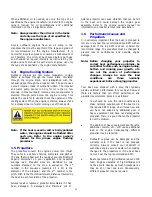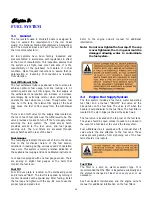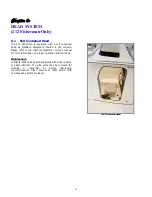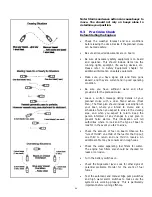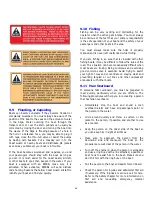
Chapter 7:
EXTERIOR EQUIPMENT
7.1
Deck
Rails and Deck Hardware
The rail system and hardware fittings have been
selected and installed to perform specific functions.
Recessed hand rails and other grab rails are installed to
provide a handhold in certain areas of the boat. You
should make sure you keep at least one hand on the
handholds as you move about the boat.
Mooring lines should be secured to the cleats and not to
rails or stanchions. Be sure a clear lead exists when
running dock or anchor lines. A line inadvertently run
around a stanchion or over the rail could cause damage.
Note: All fittings must be inspected periodically
for loose fit or wear and damage. Any problems
should be corrected immediately.
Anchor/Rope Locker
The anchor rope locker is in the bow of the boat and
accessed through a vertical hatch in the bow deck. The
anchor line is always stored in the locker and the bitter
end of the line should be secured to the fitting in the
locker.
The anchor rope locker is drained by a thru-hull fitting
near the bottom of the locker. It is very important to
check the drain frequently to make sure it is clean and
free flowing.
Periodically remove the anchor line from the rope locker,
rinse it with freshwater and allow it to dry in the sun.
Cleaning the anchor line regularly will reduce odors in
the anchor rope locker and increase the life of the line.
The line should also be inspected for abrasions or signs
of deterioration. Replace the line if it shows any sign of
damage or deterioration. Make sure the bitter end of the
anchor line is secured to the special fitting in the locker
when you reinstall it.
Anchor Rope Locker
7.2
Hull
Boarding Ladder
The standard boarding ladder is installed on the port
transom. It is held in the storage position by a retaining
strap. To use the ladder you will need to undo the strap
and fold out the ladder.
To use the optional boarding ladder, remove it from the
storage clips and slide the studs into the ladder bracket
on the port side of the transom. The ladder floats and
must be secured to the bracket in the boarding position
with a quick release pin. The ladder bracket has a
special feature that allows the ladder to swing up in the
event that the boat is operated without removing the
ladder. This helps to prevent damage to the ladder and
bracket.
Note: The ladder must be removed from the
transom bracket and properly secured to the
storage clips before starting the engines.
35
Summary of Contents for 180 Sportsman
Page 2: ...2...
Page 4: ...4...
Page 7: ...180 FISHERMAN SPECIFICATIONS 7...
Page 8: ...180 SPORTSMAN SPECIFICATIONS 8...
Page 9: ...202 FISHERMAN SPECIFICATIONS 9...
Page 10: ...212 FISHERMAN SPECIFICATIONS 10...
Page 18: ...18...
Page 39: ...SAFETY LABELS 2601 1124 39...
Page 40: ...180 FISHERMAN 180 SPORTSMAN CAPACITY LABELS 40...
Page 41: ...202 212 FISHERMAN CAPACITY LABELS 41...
Page 61: ...Appendix A SCHEMATICS 180 FISHERMAN INSTRUMENT PANEL 61...
Page 62: ...Appendix A SCHEMATICS 180 SPORTSMAN INSTRUMENT PANEL 62...
Page 63: ...Appendix A SCHEMATICS 202 212 FISHERMAN INSTRUMENT PANEL 63...
Page 68: ...Appendix A SCHEMATICS 180 FISHERMAN 180 SPORTSMAN TRAILER DRAWING 68...
Page 69: ...Appendix A SCHEMATICS 202 212 FISHERMAN TRAILER DRAWING 69...
Page 70: ...Appendix A SCHEMATICS 180 FISHERMAN OVERHEAD LAYOUT 70...
Page 71: ...Appendix A SCHEMATICS 180 SPORTSMAN OVERHEAD LAYOUT 71...
Page 72: ...Appendix A SCHEMATICS 202 FISHERMAN OVERHEAD LAYOUT 72...
Page 73: ...Appendix A SCHEMATICS 212 FISHERMAN OVERHEAD LAYOUT 73...
Page 77: ...MAINTENANCE LOG 77...
Page 78: ...MAINTENANCE LOG 78...
Page 80: ...Appendix D BOAT ACCIDENT REPORT 80...
Page 81: ...81...
Page 87: ...Appendix F TROUBLESHOOTING GUIDE 87...
Page 88: ...TROUBLESHOOTING GUIDE 88...
Page 89: ...TROUBLESHOOTING GUIDE 89...
Page 90: ...TROUBLESHOOTING GUIDE 90...
Page 91: ...TROUBLESHOOTING GUIDE 91...



